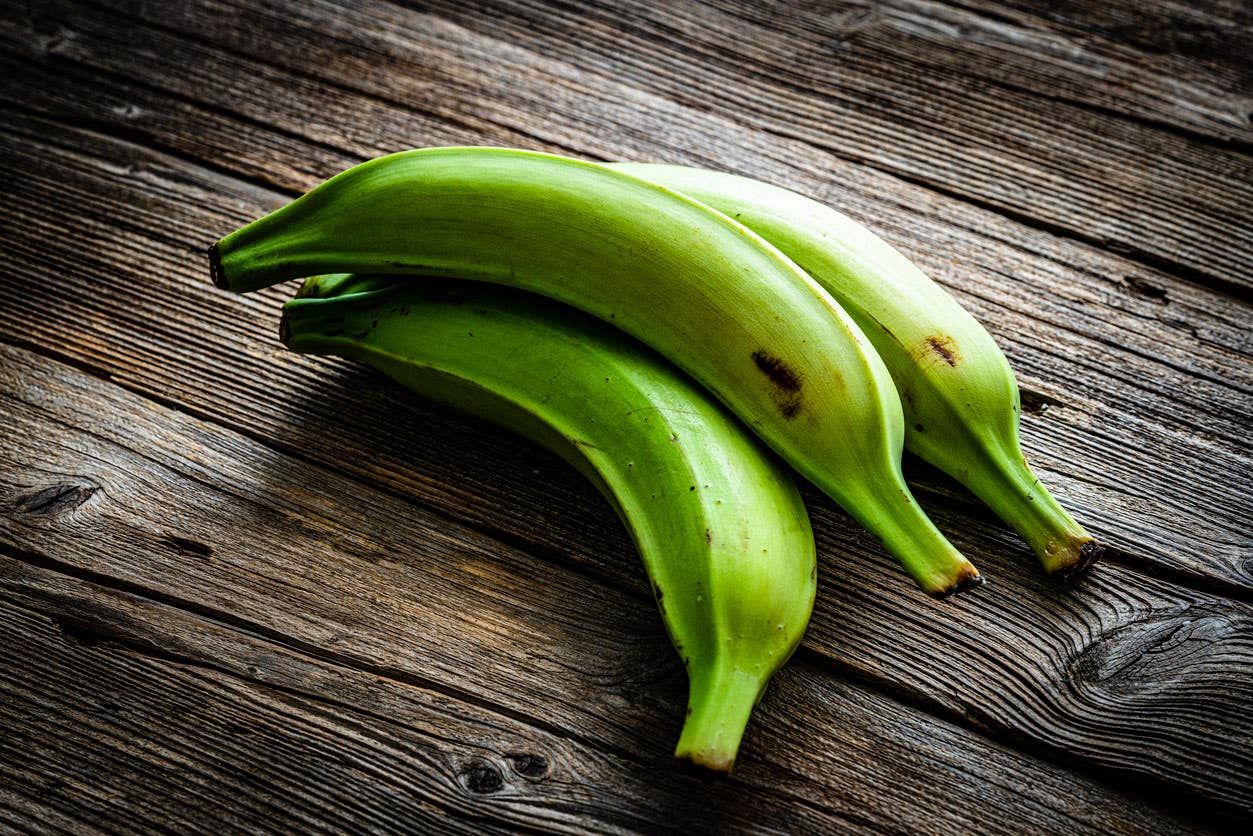
Plantains, Explained: Everything You Need to Know to Start Cooking with the Latin American Favorite
Got a recipe that calls for plantains? An urge to recreate a plantain dish you tasted in a Caribbean or Latin American restaurant? Maybe you’re just curious about how to use those big banana-like fruits in the supermarket. Whatever your reason for wanting to learn more about plantains, here’s everything you need to know, including how to peel, roast, air-fry, boil, and steam them.
What Are Plantains?
Plantains, sometimes called cooking bananas, are large, starchy, thick-skinned cousins of bananas. They’re a staple food in tropical regions around the world, where they are used ripe, unripe, and extra-ripe in both sweet and savory recipes.
Plantains vs. Bananas
Plantains may look a lot like the sweet “dessert” bananas they’re related to, but there are several key differences in appearance, taste, texture, and use. First off, plantains are noticeably larger and less curved than bananas. At the supermarket, they’ve usually been separated into individual fruits instead of being sold in bunches like bananas. Plantains have a noticeably thicker skin with more pronounced dark markings and less-vibrant coloring than bananas.
But the biggest difference between plantains and bananas is their starch content. Plantains have nine times more starch than fully ripe bananas and a nutritional profile that’s similar to potatoes. That high starch content makes green and ripe plantains taste less sweet than bananas; it also means plantains need to be cooked to be edible.
Varieties, Shopping, and Storage
Like bananas, plantains continue to ripen after they are picked, and their color changes from green to yellow, and finally to black.
Green Plantains
Green plantains have been picked when the fruits are mature but haven’t ripened. They are starchy and dry when cooked, and can be used any way you’d prepare potatoes, with similar cooking times. Most savory plantain recipes call for green plantains.
Look for green plantains with a hint of yellow. That touch of ripening color indicates the fruit was picked when fully mature, and they will continue to ripen when stored at room temperature. Immature plantains will never ripen once picked and can have a mealy texture when cooked.
Ripe Plantains
Ripe plantains are either partially or totally yellow. They are softer than green plantains and have a hint of sweetness; the yellower the plantain, the sweeter it will taste.
Avoid ripe plantains that show signs of molding around the stem. Give each fruit a gentle squeeze before choosing. It should feel firm but not hard, with a little give. Store ripe plantains at room temperature if using immediately or if you wish them to ripen further. Ripe plantains can also be refrigerated in a plastic bag or container for up to two weeks.
Ultra-Ripe Plantains
Ultra-ripe plantains are mostly black with only a little yellow. They have a banana-like sweetness but still need to be cooked to be enjoyed because of their high starch content. They are a favorite in desserts because a lot of their starch has been converted to sugar, so they caramelize easily and become soft and creamy.
Very ripe plantains are easily bruised, so it’s best to ripen yellow plantains at home by storing them at room temperature. Use before the plantains turn soft or the skins begin to shrivel.
How to Peel and Cut Plantains
Because plantains have skins that are very thick and firm, a knife is needed to peel them. First, cut off the ends with a sharp knife, then slice each plantain in half crosswise. Score the skin of each half lengthwise without cutting into the flesh—the same way you’d score the skin to peel an orange. Gently loosen the skin, and pull it away from the flesh. Discard the skin, then slice the plantain pieces into coins, planks, sticks, or oblong disks on a bias.
Do Plantains Need to Be Soaked in Salt Water Before Cooking?
Some recipes call for soaking plantains in salt water for 10 to 30 minutes before cooking. While soaking is not necessary, it does prevent plantains from browning after they have been peeled and cut and keeps them moist when roasted or air-fried.
Soaking is usually recommended for green plantains because they can have a sticky sap coating just beneath the skin. If you want to soak your plantains before using, prepare a brine by stirring 1 teaspoon of salt into 4 cups of water. Drop peeled plantain pieces in the water and soak for at least 10 minutes. Drain, pat dry, and use as directed in recipes.
Easy Ways to Cook Plantains
Roasted or Air-Fried: The easiest way to prepare plantains is to roast or air-fry them until crisp. Slice green or ripe plantains into thin rounds on a bias, then lay them in a single layer on a parchment-lined baking sheet. Roast in a 400˚F oven for 15 to 20 minutes or place in a 350˚F air fryer for TK 10 to 15 minutes, turning the pieces once during the cooking time so they brown evenly. See our Jerk Grain Bowls with Air-Fried Plantain Chips and Mojo-Seasoned Plantain Salad with Black Beans and Rice for more inspiration.
Boiled or Steamed: Boiled, mashed plantains can be served on their own, like mashed potatoes, or used as a binder, as in our Black Bean and Plantain Burgers with Salvadoran Corn Tortillas. Place peeled chunks of plantains in a pot of boiling water for 10 to 15 minutes, or until easily pierced with the tip of a knife, but not mushy. Alternatively, you can boil or steam halved plantains 15 minutes and serve them like steamed potatoes as a side dish.
Skillet-Sauteed: Try slicing green or yellow plantains on the bias and cooking them until browned on the edges in a nonstick skillet over medium heat.
Recipe: Oil-Free Tostones
One of the most popular ways to prepare plantains is to make fried green plantains or tostones. Traditionally, tostones are deep-fried twice to give them a crispy exterior and a creamy interior. In this oil-free version, the technique is adapted for an air fryer. It calls for jerk seasoning to give the tostones some flavor and spice, but you could also use your favorite seasoning blend or no seasoning at all.
1 teaspoon sea salt
2 green plantains
1 teaspoon salt-free jerk seasoning
- In a large bowl, stir the salt into 4 cups cold water until dissolved.
- Peel the plantains and slice into 1½ inch chunks. Drop plantain chunks into the salted water, and let soak 20 minutes.
- Drain well, wipe out the bowl, then return plantain chunks to bowl and toss with jerk seasoning.
- Lay plantain chunks flat in an air-fryer basket, then air-fry at 350˚F for 6 to 8 minutes or until plantains are beginning to brown. Transfer plantains to a cooling rack, and cool until easy to handle.
- Increase the air fryer temperature to 400˚F.
- Place each cooled plantain chunk between two pieces of parchment paper. Using a can or the base of a mug, mash them flat. Return the mashed plantain disks to the air fryer in a single layer, working in batches if needed. Air-fry 6 to 8 minutes or until the tostones are crisp and browned on the edges, turning once during cooking time. Serve hot or at room temperature.
To learn delicious vegan recipes and master whole-food, plant-based culinary techniques at home, check out Forks Over Knives Cooking Courses!
About the Author

About the Author
Mary Margaret Chappell
Join our mailing list
Get free recipes and the latest info on living a happy, healthy plant-based lifestyle.
By providing your email address, you consent to receive newsletter emails from Forks Over Knives. We value your privacy and will keep your email address safe. You may unsubscribe from our emails at any time.
